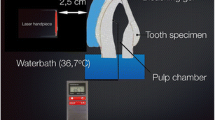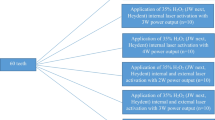Abstract
The purpose of this pilot in vitro study was to evaluate the temperature increase in the pulp chamber of the teeth, during Er,Cr:YSGG bleaching, as well as to show which teeth are the most susceptible in terms of pulp temperature increase during laser-activated bleaching treatment. Although Er:YAG studies have been published on this subject, it is the first time Er,Cr:YSGG wavelength is tested. Fifteen teeth were tested—3 each of the following—(maxillary central incisors, lateral incisors, canines, premolars and mandibular incisors). The bleaching procedure comprised an Er,Cr:YSGG laser (2780 nm, Waterlase MD, Biolase, USA) and a yellow-coloured bleaching agent with a concentration of 38 % H2O2 (Power whitening, WHITEsmile GmbH, Germany). The tip used was a 6-mm long Z-type glass tip (MZ8) of a 800 μm diameter. Average output power was set to 1.25 W, pulse duration 700 μs (S-mode), whilst the pulse repetition rate was 10 Hz. The results showed that the most susceptible teeth in terms of pulp temperature increase were the lateral maxillary incisors and the mandibular incisors. The mean temperature increase on these teeth was 1.06 and 1.00 °C, respectively, on 60 s Er,Cr:YSGG-supported bleaching.






Similar content being viewed by others
References
Goldstein RE, Garber DA (1995) Complete dental bleaching. Quintessence, Carol Stream
Burmahl B (1998) Bleaching business is booming: in-office, at home, and over the counter. AGD Impact 4:20–24
Howe-Grant M (1992) Encyclopedia of chemical technology, vol 13, 4th edn. John Wiley and Sons, New York
Abbot CH (1918) Bleaching discolored teeth by means of 30% perhydrol and the electric light rays. J Allied Dent Soc 13:259
Stellman JM (1998) Encyclopaedia of Occupational Health and Safety: Guides, indexes, directory. Int Labour Org 104:350
Buchalla W, Attin T (2007) External bleaching therapy with activation by heat, light or laser—a systematic review. Dent Mater 23:586–596
Zach L, Cohen C (1965) Pulp response to externally applied heat. Oral Surg Oral Med Oral Pathol 19:515–530
Nyborg H, Brännström M (1968) Pulp reaction to heat. J Prosthet Dent 19:605–612
Erikkson A, Albrektsson T, Grane B, McQueen D (1982) Thermal injury to bone. A vital microscopic description of heat effects. Int J Oral Surg 11:115–121
Sulieman M, Addy M, Rees JS (2005) Surface and intra-pulpal temperature rises during tooth bleaching: an in vitro study. Braz Dent J 199:37–40
Sari T, Celik G, Usumez A (2015) Temperature rise in pulp and gel during laser-activated bleaching: in vitro. Lasers Med Sci 30(2):577–582
Eldeniz AU, Usumez A, Usumez S, Ozturk N (2005) Pulpal temperature rise during light-activated bleaching. J Biomed Mater Res B Appl Biomater 72:254–259
Wetter NU, Walverde D, Kato IT, Eduardo CP (2004) Bleaching efficacy of whitening agents activated by xenon lamp and 960-nm diode radiation. Photomed Laser Surg 22:489–493
Gutknecht N, Franzen R, Meister J, Matjaz L, Pirnat S, Zabkar J, Cencic B, Jovanovic J (2011) A novel Er:YAG laser-assisted tooth whitening method. J LAHA 1:1–10
Dionysopoulos D, Strakas D, Koliniotou-Koumpia E (2015) The influence of a novel in‐office tooth whitening procedure using an Er, Cr:YSGG laser on enamel surface morphology. Laser Surg Med 47:503–511
Apel C, Meister J, Ioana RS, Franzen R, Hering P, Gutknecht N (2002) The ablation threshold of Er:YAG and Er:YSGG laser radiation in dental enamel. Lasers Med Sci 17:246–252
Joiner A (2006) The bleaching of teeth: a review of the literature. J Dent 34:412–419
Dostalova T, Jelinkova H, Housova D, Sulc J, Nemec M, Miyagi M, Brugnera A, Jr., Zanin F (2004) Diode laser-activated bleaching. Braz Dent J 15 Spec No:SI-3-8
Baik JW, Rueggeberg FA, Liewehr FR (2001) Effect of light enhanced bleaching on in vitro surface and intrapulpal temperature rise. J Esthet Restor Dent 13:370–378
Sulieman M (2005) An overview of bleaching techniques: 3. In- surgery or power bleaching. Dent Update 32:101–108
Franzen R (2011) Principles of Medical and Dental Lasers. Lulu Publications, p 116–117
Author information
Authors and Affiliations
Corresponding author
Ethics declarations
Conflict of interest
The authors declare that they have no competing interests.
Rights and permissions
About this article
Cite this article
Strakas, D., Tolidis, K., Koliniotou-Koumpia, E. et al. Intra-pulpal temperature rise of different tooth types during dental bleaching supported by an Er,Cr:YSGG laser. A pilot study. Lasers Med Sci 31, 77–82 (2016). https://doi.org/10.1007/s10103-015-1831-5
Received:
Accepted:
Published:
Issue Date:
DOI: https://doi.org/10.1007/s10103-015-1831-5




